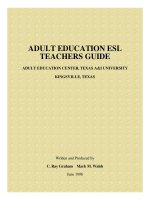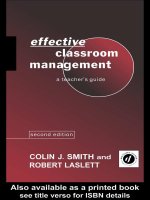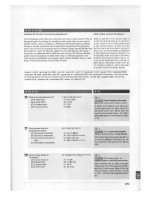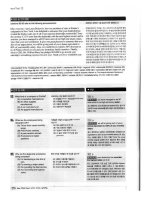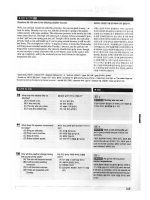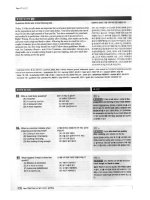Listening planner 2 (2ed) SB teachers guide (script, answer keys 포함)
Bạn đang xem bản rút gọn của tài liệu. Xem và tải ngay bản đầy đủ của tài liệu tại đây (3.4 MB, 127 trang )
Unit1|Each
|
[Pick
the
date]
Day of the Week, I Am Very
Busy.
ListeningPlanner 2: Teacher’s Guide
Unit Objectives:
1. Students will learn about daily routines.
2. Students will learn about identifying daily activities.
3. Students will learn about understanding a class presentation about a weekly schedule.
4. Students will understand the meaning of new words and be able to use the words in sentences.
5. Students will practice listening comprehension skills –identifying main idea and supporting details.
6. Students will learn skills in key points of expressions and vocabulary.
Key Words and Phrases:
volunteer work, elderly, assignment, due, available, animal shelter, seem, come
over, algebra, ready, weekly, cycling, race, improve, playground, separate,
garbage, sculpture, eat out, fancy, maniac, organized, successful, scheduled,
activity
LESSON GUIDE
Warm Up
This section is designed to preview the vocabulary and activate learners’ schema in order to
prepare them for the unit.
Build Up Vocabulary
Short monologues allow the learners to become familiar with the new vocabulary they will use
throughout the unit.
Take this opportunity to conduct a brief brainstorming session with the students in terms of the
topic being covered. Offer various examples (personal) and try to model standard answers for
the students. Then thoroughly explain the directions and have the students complete the
exercise.
Talk It Over
This activity actively engages learners by encouraging them to speak about the unit’s topic using
the new vocabulary and phrases they have learned. After reading the instructions, give the
students some time to write a few point-form sentences about what they would like to say. Then
have them talk about their ideas with a partner. Although the focus of this activity is on speaking
and not writing, for higher-level students, teachers can ask students to write out their thoughts in
full sentences before having them talk with their partner.
Extra Idea (optional):
1
Memory Game: Simply write words on the board, the students close their eyes and you erase
one.| They open their eyes and guess which word is missing by saying it (or you could have them
spell
[Pickit out.)
the
date]
Task 1
A variety of real-life conversations help learners build their listening comprehension skills.
All-around Listening
Learners focus on finding and understanding both the main idea and general information from
the dialogue. Thoroughly explain the directions to the students before playing the recording.
After hearing the recording once, have the students complete the exercises. Then go over the
answers as a class.
Close-up Listening
Learners listen for more detailed information in order to gain a better understanding of the
dialogue. Thoroughly explain the directions to the students before playing the recording a second
time. After hearing the recording again, have the students complete the exercises. Then go over
the answers as a class.
Task 2
A variety of real-life conversations help learners build their listening comprehension skills.
All-around Listening
Learners focus on finding and understanding both the main idea and general information from
the dialogue. Thoroughly explain the directions to the students before playing the recording.
After hearing the recording once, have the students complete the exercises. Then go over the
answers as a class.
Close-up Listening
Learners listen for more detailed information in order to gain a better understanding of the
dialogue. Thoroughly explain the directions to the students before playing the recording a second
time. After hearing the recording again, have the students complete the exercises. Then go over
the answers as a class.
Task 3
Learners are exposed to lectures, commercials, interviews, class presentations, announcements,
TV shows, and news reports in order to further strengthen their listening skills.
Build Up Background
This section provides learners with background information by asking them to choose the best
description of a picture related to the topic. They can discuss their answers as a class. Ask the
students what they see in the picture given. Encourage brainstorming and try to have the
2
students list as many things possible. Then have the students select the best description of the
given
| picture.
[Pick
Build
the Up Note-taking Skills
date]
This activity is designed to boost learners’ note-taking abilities, a necessary skill for completing
higher-level listening tasks. Thoroughly explain the directions of the exercise to the students.
Then play the recording. For weaker students you may have to play the recording more than
once. After listening to the recording have the students complete the notes and go over the
answers as a class. You may need to have students write their answers on the board to ensure
correct spelling.
Build Up Listening Skills
General listening skills are presented in this section to help learners improve their listening
strategies. Play the recoding for the students again. Then have the students complete the
listening comprehension questions. When the students have completed, go over the answers as
a class.
Your Turn
This section promotes critical thinking by helping learners make connections between the text
and themselves. At the same time, learners will strengthen their communicative skills as they
discuss their answers with a partner or present them to their class.
Place the students in pairs or groups. Have them fill in the blanks when applicable. When
finished, have the students present their completed work to their partner or group.
Extra Idea (optional):
Spell Race: Divide the class into 2 teams, and then have 1 student from each team stand in front
of the board. Say a key word or phrase and the first student from each team has to write it
correctly on the board for their team to gain a point. Then the next pair of students take a turn
and so on.
Test Yourself
Learners review what they have studied and check their understanding of the unit. This section
also helps prepare learners for standardized listening tests.
Explain all of the directions to the students thoroughly. Then play each respective recording for
the students. For weaker students you may have the play the recordings more than once. When
all the students have completed the Test, go over the answers as a class.
Workbook
Vocabulary List
Introduce the students to the vocabulary of the unit by playing the recording of the vocabulary.
After playing the recording, make sure the students are aware of the meanings of each of the
3
vocabulary words. Reinforce student understanding by offering additional explanation for the
vocabulary
|
when necessary. Then play the recording again, and have the students repeat aloud.
[Pick
Extra
Idea (optional):
the
date]
Yes/No Chairs: Place one chair at each end of the classroom. Stick a piece of paper with 'yes'
written on it on one of the chairs, and a 'no' on the other. Divide the class into two teams, and
ask a yes/no question. For example: "Can pigs fly?" To win a point for his/her team, the student
must run to the correct chair. In this case 'no' and then answer the question correctly: "No, pigs
can’t fly." If they get the answer wrong, the other team can answer for the point. This game can
be adapted to true/false chairs, where students have to determine the truth of various
statements. Take care, of course, that the statements are within the children's general
knowledge.
Word Dictation
A) Explain the directions to the students, and make sure they fully understand the exercise. Then
play the recording for the students (for weaker students, play the recording more than once).
B) For this exercise have students write the definition of each vocabulary word in their native
language.
Dialogue Dictation
Task 1 Dialogue: Explain the directions to the students, and make sure they fully understand the
exercise. Then play the dialogue for the students (for weaker students, play the recording more
than once), and have them fill in the blanks. After the students have completed their dictation go
over the answers as a class, or call on individual students to present their answers. You may
want to write the answers on the board to ensure that the students have spelled the words
correctly.
Task 2 Dialogue: Explain the directions to the students, and make sure they fully understand the
exercise. Then play the dialogue for the students (for weaker students, play the recording more
than once), and have them fill in the blanks. After the students have completed their dictation go
over the answers as a class, or call on individual students to present their answers. You may
want to write the answers on the board to ensure that the students have spelled the words
correctly.
Task 3 Monologue: Explain the directions to the students, and make sure they fully understand
the exercise. Then play the story for the students (for weaker students, play the recording more
than once), and have them fill in the blanks. After the students have completed their dictation go
over the answers as a class, or call on individual students to present their answers. You may
want to write the answers on the board to ensure that the students have spelled the words
correctly.
Situation: Discuss the choices given at the bottom of the page. If needed offer students
examples and explain the specific differences of each item listed. Then have the students select
the correct situation for the monologue. When the students are finished go over the answers as a
class.
4
SCRIPTS &ANSWER KEYS
|
[Pick
the
date]
5
|
[Pick
the
date]
6
|
[Pick
the
date]
7
|
[Pick
the
date]
8
Unit2|I
Have a Round Face, Which Looks
Just Like My Sister’s.
|
[Pick
the
date]
ListeningPlanner 2: Teacher’s Guide
Unit Objectives:
1. Students will learn about expressions describing people’s appearance.
2. Students will learn about identifying people by physical descriptions.
3. Students will learn about understanding a shopping mall announcement.
4. Students will understand the meaning of new words and be able to use the words in sentences.
5. Students will practice listening comprehension skills –identifying main idea and supporting details.
6. Students will learn skills in key points of expressions and vocabulary.
Key Words and Phrases:
perm, opposite, ponytail, tanned, attractive, smooth, crowd, shortly, describe, It
has been a long time since, pull in, similar, height, freckle, get off, twin,
announcement, carry, item, purchase, disappear, information, contact,
overweight, write down
LESSON GUIDE
Warm Up
This section is designed to preview the vocabulary and activate learners’ schema in order to
prepare them for the unit.
Build Up Vocabulary
Short monologues allow the learners to become familiar with the new vocabulary they will use
throughout the unit.
Take this opportunity to conduct a brief brainstorming session with the students in terms of the
topic being covered. Offer various examples (personal) and try to model standard answers for
the students. Then thoroughly explain the directions and have the students complete the
exercise.
Talk It Over
This activity actively engages learners by encouraging them to speak about the unit’s topic using
the new vocabulary and phrases they have learned. After reading the instructions, give the
students some time to write a few point-form sentences about what they would like to say. Then
have them talk about their ideas with a partner. Although the focus of this activity is on speaking
and not writing, for higher-level students, teachers can ask students to write out their thoughts in
full sentences before having them talk with their partner.
Extra Idea (optional):
9
Word Tennis: Divide the class into 2 teams. Write the team names on either side of the board at
the top.
|
Leave a space in the middle of the board to write a list of categories. Write the first
category
[for example, animals]. Have the students read this to you, if they can't read it yet, you
[Pick
can
the read it to them. Repeated exposure to the category names will help them recognize them.
Point
date] quickly to the first student. The student must respond with an animal name within a few
seconds. Then the 'ball' bounces to the other team, and the first student quickly gives the name
of another animal. Then the second student on the other team answers. This game must be done
quickly, and without any repetition of vocabulary. When a student cannot answer, a point is given
to the opposing team, and a new category is written on the board. The whole process is then
repeated. Ideally this game should be a fast review of vocabulary items.
Task 1
A variety of real-life conversations help learners build their listening comprehension skills.
All-around Listening
Learners focus on finding and understanding both the main idea and general information from
the dialogue. Thoroughly explain the directions to the students before playing the recording.
After hearing the recording once, have the students complete the exercises. Then go over the
answers as a class.
Close-up Listening
Learners listen for more detailed information in order to gain a better understanding of the
dialogue. Thoroughly explain the directions to the students before playing the recording a second
time. After hearing the recording again, have the students complete the exercises. Then go over
the answers as a class.
Task 2
A variety of real-life conversations help learners build their listening comprehension skills.
All-around Listening
Learners focus on finding and understanding both the main idea and general information from
the dialogue. Thoroughly explain the directions to the students before playing the recording.
After hearing the recording once, have the students complete the exercises. Then go over the
answers as a class.
Close-up Listening
Learners listen for more detailed information in order to gain a better understanding of the
dialogue. Thoroughly explain the directions to the students before playing the recording a second
time. After hearing the recording again, have the students complete the exercises. Then go over
the answers as a class.
Task 3
Learners are exposed to lectures, commercials, interviews, class presentations, announcements,
TV shows, and news reports in order to further strengthen their listening skills.
Build Up Background
10
This section provides learners with background information by asking them to choose the best
description
|
of a picture related to the topic. They can discuss their answers as a class. Ask the
students
what
they see in the picture given. Encourage brainstorming and try to have the
[Pick
students
list as many things possible. Then have the students select the best description of the
the
given
date] picture.
Build Up Note-taking Skills
This activity is designed to boost learners’ note-taking abilities, a necessary skill for completing
higher-level listening tasks. Thoroughly explain the directions of the exercise to the students.
Then play the recording. For weaker students you may have to play the recording more than
once. After listening to the recording have the students complete the notes and go over the
answers as a class. You may need to have students write their answers on the board to ensure
correct spelling.
Build Up Listening Skills
General listening skills are presented in this section to help learners improve their listening
strategies. Play the recoding for the students again. Then have the students complete the
listening comprehension questions. When the students have completed, go over the answers as
a class.
Your Turn
This section promotes critical thinking by helping learners make connections between the text
and themselves. At the same time, learners will strengthen their communicative skills as they
discuss their answers with a partner or present them to their class.
Place the students in pairs or groups. Have them fill in the blanks when applicable. When
finished, have the students present their completed work to their partner or group.
Extra Idea (optional):
Pictionary: Divide the class into two teams. Call on 1 student at a time to draw on the board.
Each student is permitted only to draw on the board in front of the class. They cannot use any
symbols, numbers or letters in what they draw. The rest of the team should shout out any
answers that come to mind. If the team is able to guess the word within the designated time,
they score a point. If after two minutes the team has not guessed the word correctly, the other
team gets one chance to guess the word. If they are correct, they score a point and then
continue with their turn. Continue playing until you run out of time or you run out of words. The
team with the higher score at the end of the game wins.
Test Yourself
Learners review what they have studied and check their understanding of the unit. This section
also helps prepare learners for standardized listening tests.
Explain all of the directions to the students thoroughly. Then play each respective recording for
the students. For weaker students you may have the play the recordings more than once. When
all the students have completed the Test, go over the answers as a class.
Workbook
Vocabulary List
11
Introduce the students to the vocabulary of the unit by playing the recording of the vocabulary.
After| playing the recording, make sure the students are aware of the meanings of each of the
vocabulary
words. Reinforce student understanding by offering additional explanation for the
[Pick
vocabulary
when necessary. Then play the recording again, and have the students repeat aloud.
the
date]
Extra Idea (optional):
Bingo: Give your students a blank bingo boards and ask them to put the review words into the
squares randomly. You should have some strategy for choosing the words to call and then which
your students will mark on the cards. You can write the words on cards and choose them
randomly from the deck or simply put small slips of paper into a hat to draw randomly. Once you
have chosen the word do not read it. Instead, give the definition of the word to your class. Each
person must then determine if he has the word that corresponds to the definition on their bingo
board. When anyone gets five squares in a row, they should shout, “Bingo!” Warn your students
not to clear their boards until you have checked the winner’s words to make sure they did not
have an incorrect answer. Give the winner of each round a prize or allow them to call the words
for the next round though you may need to supply the definitions.
Word Dictation
A) Explain the directions to the students, and make sure they fully understand the exercise. Then
play the recording for the students (for weaker students, play the recording more than once).
B) For this exercise have students write the definition of each vocabulary word in their native
language.
Dialogue Dictation
Task 1 Dialogue: Explain the directions to the students, and make sure they fully understand the
exercise. Then play the dialogue for the students (for weaker students, play the recording more
than once), and have them fill in the blanks. After the students have completed their dictation go
over the answers as a class, or call on individual students to present their answers. You may
want to write the answers on the board to ensure that the students have spelled the words
correctly.
Task 2 Dialogue: Explain the directions to the students, and make sure they fully understand the
exercise. Then play the dialogue for the students (for weaker students, play the recording more
than once), and have them fill in the blanks. After the students have completed their dictation go
over the answers as a class, or call on individual students to present their answers. You may
want to write the answers on the board to ensure that the students have spelled the words
correctly.
Task 3 Monologue: Explain the directions to the students, and make sure they fully understand
the exercise. Then play the story for the students (for weaker students, play the recording more
than once), and have them fill in the blanks. After the students have completed their dictation go
over the answers as a class, or call on individual students to present their answers. You may
want to write the answers on the board to ensure that the students have spelled the words
correctly.
Situation: Discuss the choices given at the bottom of the page. If needed offer students
examples and explain the specific differences of each item listed. Then have the students select
12
the correct situation for the monologue. When the students are finished go over the answers as a
class.
|
[Pick
the
date]
13
SCRIPTS &ANSWER KEYS
|
[Pick
the
date]
14
|
[Pick
the
date]
15
|
[Pick
the
date]
16
|
[Pick
the
date]
17
Unit3|To
|
[Pick
the
date]
Say Yes, We Move Our Head Up
and Down.
ListeningPlanner 2: Teacher’s Guide
Unit Objectives:
1. Students will learn about different gestures.
2. Students will learn about identifying different cultures.
3. Students will learn about understanding a lecture about cultural differences.
4. Students will understand the meaning of new words and be able to use the words in sentences.
5. Students will practice listening comprehension skills –identifying main idea and supporting details.
6. Students will learn skills in key points of expressions and vocabulary.
Key Words and Phrases:
cautious, from side to side, tour guide, to culture, dining etiquette, Muslim, Hindu,
religion, worship, filthy, else, messy, host, pay for, meal, lecture, cultural,
handshake, firm, forearm, greeting, curtsy, slightly, consider, maintain
LESSON GUIDE
Warm Up
This section is designed to preview the vocabulary and activate learners’ schema in order to
prepare them for the unit.
Build Up Vocabulary
Short monologues allow the learners to become familiar with the new vocabulary they will use
throughout the unit.
Take this opportunity to conduct a brief brainstorming session with the students in terms of the
topic being covered. Offer various examples (personal) and try to model standard answers for
the students. Then thoroughly explain the directions and have the students complete the
exercise.
Talk It Over
This activity actively engages learners by encouraging them to speak about the unit’s topic using
the new vocabulary and phrases they have learned. After reading the instructions, give the
students some time to write a few point-form sentences about what they would like to say. Then
have them talk about their ideas with a partner. Although the focus of this activity is on speaking
and not writing, for higher-level students, teachers can ask students to write out their thoughts in
full sentences before having them talk with their partner.
Extra Idea (optional):
18
Charades: Divide your class into two teams. Individuals will take turns acting out one of the
words
| from the cards that you have prepared. They will choose this card randomly on their turns
and
[Pickwill have 2 minutes to get their team to guess the word without using books or notes. The
actor
the cannot use any sounds but must communicate only through actions. The rest of the team
should
date] shout out any answers that come to mind. If the team is able to guess the word within the
designated time, they score a point. If after two minutes the team has not guessed the word
correctly, the other team gets one chance to guess the word. If they are correct, they score a
point and then continue with their turn. Continue playing until you run out of time or you run out
of words. The team with the higher score at the end of the game wins.
Task 1
A variety of real-life conversations help learners build their listening comprehension skills.
All-around Listening
Learners focus on finding and understanding both the main idea and general information from
the dialogue. Thoroughly explain the directions to the students before playing the recording.
After hearing the recording once, have the students complete the exercises. Then go over the
answers as a class.
Close-up Listening
Learners listen for more detailed information in order to gain a better understanding of the
dialogue. Thoroughly explain the directions to the students before playing the recording a second
time. After hearing the recording again, have the students complete the exercises. Then go over
the answers as a class.
Task 2
A variety of real-life conversations help learners build their listening comprehension skills.
All-around Listening
Learners focus on finding and understanding both the main idea and general information from
the dialogue. Thoroughly explain the directions to the students before playing the recording.
After hearing the recording once, have the students complete the exercises. Then go over the
answers as a class.
Close-up Listening
Learners listen for more detailed information in order to gain a better understanding of the
dialogue. Thoroughly explain the directions to the students before playing the recording a second
time. After hearing the recording again, have the students complete the exercises. Then go over
the answers as a class.
Task 3
Learners are exposed to lectures, commercials, interviews, class presentations, announcements,
TV shows, and news reports in order to further strengthen their listening skills.
Build Up Background
19
This section provides learners with background information by asking them to choose the best
description
|
of a picture related to the topic. They can discuss their answers as a class. Ask the
students
what
they see in the picture given. Encourage brainstorming and try to have the
[Pick
students
list as many things possible. Then have the students select the best description of the
the
given
date] picture.
Build Up Note-taking Skills
This activity is designed to boost learners’ note-taking abilities, a necessary skill for completing
higher-level listening tasks. Thoroughly explain the directions of the exercise to the students.
Then play the recording. For weaker students you may have to play the recording more than
once. After listening to the recording have the students complete the notes and go over the
answers as a class. You may need to have students write their answers on the board to ensure
correct spelling.
Build Up Listening Skills
General listening skills are presented in this section to help learners improve their listening
strategies. Play the recoding for the students again. Then have the students complete the
listening comprehension questions. When the students have completed, go over the answers as
a class.
Your Turn
This section promotes critical thinking by helping learners make connections between the text
and themselves. At the same time, learners will strengthen their communicative skills as they
discuss their answers with a partner or present them to their class.
Place the students in pairs or groups. Have them fill in the blanks when applicable. When
finished, have the students present their completed work to their partner or group.
Extra Idea (optional):
Stand and Spell: Make list of words for students to spell. Write students' names on the board.
Give each student one letter to be and write it next to their names. Call out a word to be spelled.
Students stand next to each other to spell the word.
Test Yourself
Learners review what they have studied and check their understanding of the unit. This section
also helps prepare learners for standardized listening tests.
Explain all of the directions to the students thoroughly. Then play each respective recording for
the students. For weaker students you may have the play the recordings more than once. When
all the students have completed the Test, go over the answers as a class.
Workbook
Vocabulary List
20
Introduce the students to the vocabulary of the unit by playing the recording of the vocabulary.
After| playing the recording, make sure the students are aware of the meanings of each of the
vocabulary
words. Reinforce student understanding by offering additional explanation for the
[Pick
vocabulary
when necessary. Then play the recording again, and have the students repeat aloud.
the
date]
Extra Idea (optional):
Back Writing: Have students sit in a circle for a smaller class or make team lines for a larger
class. Choose a letter or word from the unit’s key words and phrases and have children trace it in
the air together. Next, have students trace the letter onto the back of the person in front of them.
Observe the students and correct where necessary. Repeat using new letters. Use words or
sentences for higher levels.
Word Dictation
A) Explain the directions to the students, and make sure they fully understand the exercise. Then
play the recording for the students (for weaker students, play the recording more than once).
B) For this exercise have students write the definition of each vocabulary word in their native
language.
Dialogue Dictation
Task 1 Dialogue: Explain the directions to the students, and make sure they fully understand the
exercise. Then play the dialogue for the students (for weaker students, play the recording more
than once), and have them fill in the blanks. After the students have completed their dictation go
over the answers as a class, or call on individual students to present their answers. You may
want to write the answers on the board to ensure that the students have spelled the words
correctly.
Task 2 Dialogue: Explain the directions to the students, and make sure they fully understand the
exercise. Then play the dialogue for the students (for weaker students, play the recording more
than once), and have them fill in the blanks. After the students have completed their dictation go
over the answers as a class, or call on individual students to present their answers. You may
want to write the answers on the board to ensure that the students have spelled the words
correctly.
Task 3 Monologue: Explain the directions to the students, and make sure they fully understand
the exercise. Then play the story for the students (for weaker students, play the recording more
than once), and have them fill in the blanks. After the students have completed their dictation go
over the answers as a class, or call on individual students to present their answers. You may
want to write the answers on the board to ensure that the students have spelled the words
correctly.
Situation: Discuss the choices given at the bottom of the page. If needed offer students
examples and explain the specific differences of each item listed. Then have the students select
the correct situation for the monologue. When the students are finished go over the answers as a
class.
21
SCRIPTS &ANSWER KEYS
|
[Pick
the
date]
22
|
[Pick
the
date]
23
|
[Pick
the
date]
24
|
[Pick
the
date]
25

